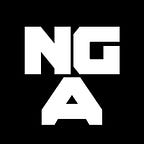Australians in the Sculpture Garden
Rebecca Blake takes us on a tour through the seasons of the National Gallery of Australia’s unique, world-renowned Sculpture Garden, with a special focus on some of the big Australians.
The National Gallery of Australia is home to one of the country’s most developed Sculpture Gardens which can be experienced at leisure 24 hours a day, 7 days a week. Situated in Canberra, on the shores of Lake Burley Griffin, the garden was formed in 1981 and was originally designed around the changing seasons. Over the years the garden has continued to flourish and evolve. The wide-ranging collection currently features more than thirty Australian sculptures across the three-hectare site.
Entering from the lakefront, via Queen Elizabeth Terrace, visitors are greeted by Virginia created in 1970 by Melbourne-born artist Clement Meadmore. The three-dimensional line sculpture is named after and dedicated to Meadmore’s friend and fellow Australian artist Virginia Cuppaidge. The corten steel form appears to defy physical reality — as the curved base perches precariously upon the ground, its arms mirror the expanse of the lake, stretching outwards. Further along the grassy knoll is Robert Klippel’s Number 751 1989 (cast 1997) which was installed in memory of Michael Loyd, the Gallery’s Assistant Director of Collections. At the edge of the lawn close to the National Gallery building lies Rick Amor’s The dog 2002. Hunched over with its weathered coat, it appears more wolf-like than domesticated canine.
Moving into the Summer Garden underneath the shade of Casuarina trees finds Bert Fugleman’s Cones 1982. More than twenty metres in length, seven geometric stainless-steel forms twist and turn upon a horizontal axis. Despite the immense weight of the polished steel, the structure floats in the landscape. The shiny surface acts like a fun-house mirror, reflecting distorted images of visitors and the surrounding landscape, making it a constant source of delight for children and adults alike.
Within the marsh pond of the Summer Garden is Robert Klippel’s Group of eight bronzes (Opus 365b-372b) 1982/3, surrounded by yellow lilies and water reeds. Klippel’s sculptures explore the intersection between nature and the machine-made, making them perfectly positioned within the Gallery’s Sculpture Garden. The design incorporates discarded wooden machinery patterns, sourced from an old mansion in Balmain, Sydney. On the concrete wall of the gallery illuminated by the eastern sun is Clement Meadmore’s two grey untitled steel sculptures, featuring three-dimensional geometric compositions of rectangular planes. These modern designs were created as decorative balcony balustrade panels for the Town House Motel in Canberra before they were salvaged and acquired by the Gallery in 1988.
The Spring Garden runs parallel to the lake and is laid out with a series of distinct, interconnecting corridors delineated by plantings of locally sourced Australian natives. Situated between beds of banksias and grevilleas lies Lisa Roet’s Orangutan foot 2007–08. Cast in bronze, Orangutan foot magnifies one specific physiological structure of the orangutan, focusing our attention on the similarities and differences between species, and the close correlations with our own existence and evolution. Further along the gravel path are the spiritually and culturally significant Pukamani burial poles 1979–84 by Tiwi people from Bathurst and Melville Islands.
As we move around the north-western side of the building up the stairs towards the original entrance to the Gallery, we are greeted with Bruce Armstrong’s beast-like Head 1986. The animalistic form was the largest sculpture Armstrong had created at the time. Sculpted from a log of red gum with a chainsaw, the raw carving engages with mythology and is imbued with a sense of materiality. Suspended in the air between the Gallery and the neighbouring High Court of Australia is Neil Dawson’s globe Diamonds 2002. The overlaid panels of painted mesh sparkle as they catch the light at different times of the day.
Continuing towards the new entrance, visitors are greeted with the aluminium sphere Eran 2010 by Thainakuith artist and master ceramist Thanakupi (Dr Thancoupie Gloria Fletcher). Thanakupi’s designs reflect her ancestor’s dreaming and incorporate native animals including kangaroos, emus and fish, which can be seen dancing across the surface in Eran, named for the Thainakuith language word for river. It was commissioned as part of the development of the new wing which opened in 2010.
Situated in the newly developed Australian Gardens on the south side of the Gallery are seven shiny steel pears by George Baldessin. His famous Pear – version number 2 1973 has been in a number of locations within the gardens over the years. Tilted towards one another, the pears suggest a gathering of people. Today they are at home next to James Turrell’s skyspace Within without 2010. Further along Bowen Place lies Inge King’s Temple gate 1976–77, inspired by archways to Shinto shrines witnessed by King during her first trip to Japan.
There’s nothing better than taking in the fresh air and admiring the sculptures in the National Gallery’s Sculpture Garden.
Rebecca Blake is the Assistant for Australian Art at the National Gallery of Australia, Canberra.
